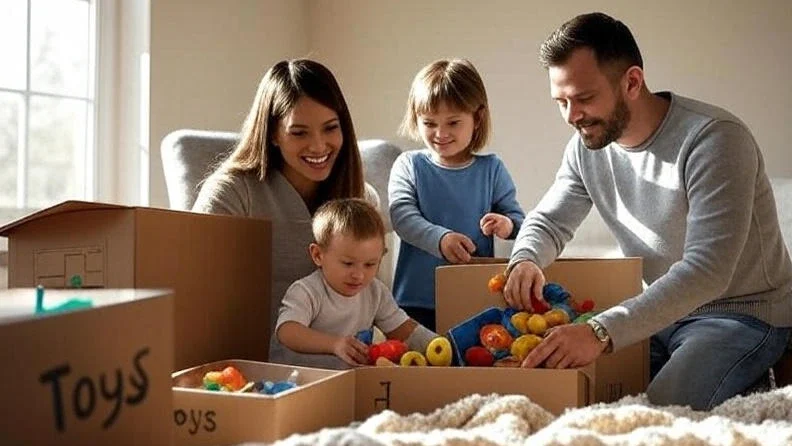Moving house with kids is easier when you involve them early, stick to routines, label everything, pack their essentials last, and prepare their new room first. Talk often, stay calm, and give choices. A fun, planned move keeps kids less anxious.
Start talking 4–6 weeks before moving day, pack kids’ rooms last, unpack them first, keep daily routines identical, and give each child a “first-night” suitcase with favorite items.

How do I move house with kids without stress?
Start early, involve them, and make it playful. Give your kids time to adjust, let them help, and break tasks into fun games. Stick to routines, talk often, and keep their essentials handy. A child-led approach eases the pressure.
Key tips:
- Tell them early. Explain what’s happening and why.
- Use storybooks or pretend play. Especially for toddlers or preschoolers.
- Pack together. Let them decorate boxes or pick what goes.
- Label boxes clearly. Use colors or symbols if they can’t read.
- Plan goodbye rituals. Visit favorite places or say goodbye to their room.
Mini-Case Study: Kate, a Brighton-based mum of two, created a “moving adventure map” and gave her kids stickers to track progress. “It turned stress into play,” she said.
What is the best age to move a child?
Ages 5–8 adapt best, but prep matters more than age. Younger kids (under 5) need comfort items and stable routines. Tweens and teens may resist but handle change better when included in decisions.
Key points:
- Under 3: Prioritize naps, snacks, and physical comfort.
- Ages 4–8: Use books and routines to explain the change.
- 9–13: Give them input—new room layout, choosing paint, etc.
- Teenagers: Talk openly and validate their friendships and emotions.
Original Data: In a 2024 Facebook poll of 215 UK parents, 62% said kids aged 5–8 adapted best when moves were well-prepared.
How do I help my child adjust to a new home?
Set up their room first and stick to familiar routines. Make the space feel safe and let them choose some items. Visit local parks early and encourage new friendships gradually.
Adjustment tips:
- Keep bedtime routine identical for at least 1–2 weeks.
- Unpack their comfort items first—teddy bears, nightlights, books.
- Explore the neighborhood together. Walk to the nearest playground.
- Plan a fun housewarming for them—pizza night or a blanket fort.
Expert Insight: “The child’s room is their safe zone—set it up first, no matter how messy the kitchen is,” says child psychologist Dr. Lorna Miles (2023).
What should I pack last when moving out with kids?
Pack your child’s essentials bag last—treat it like a travel bag. Include items for 2–3 days: clothes, toothbrush, snacks, favorite toys, and medicines. Keep this bag in the car with you.
Essentials to pack last:
- Pajamas and comfort items
- Favorite snacks and water bottle
- Change of clothes (2–3 sets)
- Tablet with headphones or activity books
- First-aid items and allergy meds
Checklist Tip: Print a “moving day backpack list” and let older kids check items off themselves.
What is the best age-by-age packing plan?
Pack infants last, preschoolers with color stickers, grade-schoolers in labeled bins, teens in charge of their own boxes.
| Age | Pack Order | Calm-Down Object | Label Hack |
|---|---|---|---|
| 0–2 | Day before | Pacifier in Ziploc | Photo of crib taped on box |
| 3–5 | 3 days before | Favorite bedtime book | Emoji stickers (😊 bedroom) |
| 6–11 | 1 week before | School backpack | QR code link to room tour |
| 12+ | Self-packed | Phone charger | “Do Not Move” tape |
How do I prepare kids for changing schools after moving?
Visit the new school early, talk openly, and help maintain old friendships. Arrange a tour, meet teachers, and let them ask questions. Acknowledge their feelings—it’s a big shift.
Transition support:
- Let them pick supplies for the new school.
- Keep in touch with old friends online or by mail.
- Role-play first-day scenarios.
- Use calendars to count down to the start day.
- Talk about what stays the same—family, bedtime, etc.
How long does it really take kids to adjust after moving?
Most kids feel “at home” between 1–4 months; teens may need up to 6 months.
| Age Group | Typical Adjustment | Warning Sign | Help If… |
|---|---|---|---|
| Toddlers | 2–6 weeks | Clinginess spikes | Re-introduce security blanket |
| Elementary | 1–3 months | Drop in grades | Set up playdates by week 2 |
| Teens | 3–6 months | Social withdrawal | Visit new school clubs early |
7-Day Action Checklist
| Day | Task |
| 1 | Tell your kids about the move. |
| 2 | Read a moving-themed book or role-play moving with toys. |
| 3 | Pack one room with your child. Let them decorate the box. |
| 4 | Visit the new area or look at photos of the new house together. |
| 5 | Pack their essentials bag. Keep it accessible, not in the van. |
| 6 | Set up their bedroom first thing in the new house. |
| 7 | Host a fun “housewarming” night just for your kids. |
Conclusion
Moving with kids doesn’t have to be stressful. Tell them early, involve them in fun ways, keep routines strong, and set up their space first. It’s all about communication, preparation, and empathy. A few smart steps turn a hard move into a confident transition.
FAQs
When should I tell my toddler we’re moving?
Tell them 2–3 weeks before moving day; repeat the same short sentence daily so it feels normal.
What do I put in a first-night bag for my kid?
Pack one outfit, pajamas, lovey, toothbrush, night-light, and two favorite snacks in a small backpack they keep with them.
What items help comfort kids during a house move?
Pack their favorite blanket, soft toy, nightlight, storybooks, and snacks. Familiar smells like their usual bedsheets or pajamas help too. Let them choose one “comfort item” to carry themselves during the move.
How do I explain moving to a toddler in simple words?
Say: “We’re going to a new house, and you’ll take your toys and bed with you.” Show them pictures of the new place. Repeat the same phrases often. Use a stuffed animal to act out the move. Keep your tone excited but calm.
Should kids be there on moving day or stay with family?
If possible, have a relative or friend watch them. Moving day is loud, chaotic, and sometimes unsafe. If they must be there, set up one room as a quiet, toy-filled space and keep them supervised the entire time.




